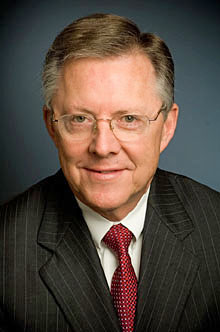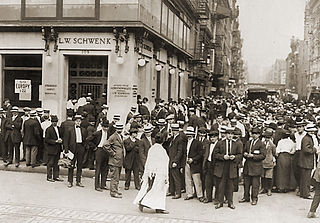Related Research Articles

The Federal Deposit Insurance Corporation (FDIC) is a United States government corporation supplying deposit insurance to depositors in American commercial banks and savings banks. The FDIC was created by the Banking Act of 1933, enacted during the Great Depression to restore trust in the American banking system. More than one-third of banks failed in the years before the FDIC's creation, and bank runs were common. The insurance limit was initially US$2,500 per ownership category, and this has been increased several times over the years. Since the enactment of the Dodd–Frank Wall Street Reform and Consumer Protection Act in 2010, the FDIC insures deposits in member banks up to $250,000 per ownership category. FDIC insurance is backed by the full faith and credit of the government of the United States, and according to the FDIC, "since its start in 1933 no depositor has ever lost a penny of FDIC-insured funds".

In the United States, banking began by the 1780s along with the country's founding and has developed into highly influential and complex system of banking and financial services. Anchored by New York City and Wall Street, it is centered on various financial services namely private banking, asset management, and deposit security.
Washington Mutual was the United States' largest savings and loan association until its collapse in 2008.
A savings and loan association (S&L), or thrift institution, is a financial institution that specializes in accepting savings deposits and making mortgage and other loans. The terms "S&L" or "thrift" are mainly used in the United States; similar institutions in the United Kingdom, Ireland and some Commonwealth countries include building societies and trustee savings banks. They are often mutually held, meaning that the depositors and borrowers are members with voting rights, and have the ability to direct the financial and managerial goals of the organization like the members of a credit union or the policyholders of a mutual insurance company. While it is possible for an S&L to be a joint-stock company, and even publicly traded, in such instances it is no longer truly a mutual association, and depositors and borrowers no longer have membership rights and managerial control. By law, thrifts can have no more than 20 percent of their lending in commercial loans—their focus on mortgage and consumer loans makes them particularly vulnerable to housing downturns such as the deep one the U.S. experienced in 2007.

The savings and loan crisis of the 1980s and 1990s was the failure of 32% of savings and loan associations (S&Ls) in the United States from 1986 to 1995. An S&L or "thrift" is a financial institution that accepts savings deposits and makes mortgage, car and other personal loans to individual members.

The Office of Thrift Supervision (OTS) was a United States federal agency under the Department of the Treasury that chartered, supervised, and regulated all federally chartered and state-chartered savings banks and savings and loans associations. It was created in 1989 as a renamed version of the Federal Home Loan Bank Board, another federal agency. Like other U.S. federal bank regulators, it was paid by the banks it regulated. The OTS was initially seen as an aggressive regulator, but was later lax. Declining revenues and staff led the OTS to market itself to companies as a lax regulator in order to get revenue.

The Financial Institutions Reform, Recovery, and Enforcement Act of 1989 (FIRREA), is a United States federal law enacted in the wake of the savings and loan crisis of the 1980s.

Flagstar Bank is a Michigan-based bank that has one of the largest residential mortgage servicers in the United States, as well as included in a list of the largest banks in the country. On April 26, 2021, New York Community Bancorp, Inc. (NYCB) issued a press release indicating that they were acquiring Flagstar Bank (FSB) in an all stock strategic merger.
NetBank, formerly named Atlanta Internet Bank (1996) and Net.B@nk (1998), was a direct bank.
IndyMac, a contraction of Independent National Mortgage Corporation, was an American bank based in California that failed in 2008 and was seized by the United States Federal Deposit Insurance Corporation (FDIC).

John M. Reich was a Director of the Federal Deposit Insurance Corporation (FDIC). He was sworn in on January 15, 2001, following an appointment by President of the United States Bill Clinton and served on the FDIC Board for eight years. Reich served as Vice Chairman of the Board of the FDIC from November 2002 until he was nominated on June 7, 2005 by President George W. Bush to be Director of the Office of Thrift Supervision (OTS), and the U.S. Senate confirmed his nomination on July 29, 2005. He also served as Acting Chairman of the FDIC from July to August 2001. As Deputy Chairman, 2001–2005, Reich served as the Chair of FDIC's Audit Committee during a time when the General Accounting Office issued reportable conditions regarding information security at the Corporation.

A bank failure occurs when a bank is unable to meet its obligations to its depositors or other creditors because it has become insolvent or too illiquid to meet its liabilities. A bank usually fails economically when the market value of its assets declines to a value that is less than the market value of its liabilities. The insolvent bank either borrows from other solvent banks or sells its assets at a lower price than its market value to generate liquid money to pay its depositors on demand. The inability of the solvent banks to lend liquid money to the insolvent bank creates a bank panic among the depositors as more depositors try to take out cash deposits from the bank. As such, the bank is unable to fulfill the demands of all of its depositors on time. A bank may be taken over by the regulating government agency if its shareholders' equity are below the regulatory minimum.
Bank regulation in the United States is highly fragmented compared with other G10 countries, where most countries have only one bank regulator. In the U.S., banking is regulated at both the federal and state level. Depending on the type of charter a banking organization has and on its organizational structure, it may be subject to numerous federal and state banking regulations. Apart from the bank regulatory agencies the U.S. maintains separate securities, commodities, and insurance regulatory agencies at the federal and state level, unlike Japan and the United Kingdom. Bank examiners are generally employed to supervise banks and to ensure compliance with regulations.
The government interventions during the subprime mortgage crisis were a response to the 2007–2009 subprime mortgage crisis and resulted in a variety of government bailouts that were implemented to stabilize the financial system during late 2007 and early 2008.

Benj. Franklin Savings and Loan was a thrift based in Portland, in the U.S. state of Oregon. Founded in 1925, the company was seized by the United States Government in 1990. In 1996 the United States Supreme Court found that this and similar seizures were based on an unconstitutional provision of the Financial Institutions Reform, Recovery, and Enforcement Act of 1989 (FIRREA). Shareholders of the thrift sued the federal government for damages caused by the seizure, with the shareholders winning several rounds in the courts. In 2013, $9.5 million was allocated for disbursement to shareholders.
The First Federal Bank of California was a community bank founded in 1929, and encompassed most of Southern California. As of 2009, it operated approximately thirty-nine branches.
Franklin Savings Association was an Ottawa, Kansas-based American Savings and loan association that was one of the largest seizures of the savings and loan crisis. Subsequent litigation established that the institution had always been in full capital compliance, a fact to which the FDIC stipulated in 2011, after 21 years of legal challenges by Franklin's shareholders. Also, the FDIC refused to open its books to a bankruptcy judge and never demonstrated that the seizure resulted in a loss to the American taxpayers. It is widely believed that Franklin's assets, which had a book value of more than $380 million when seized, were ultimately sold by the government to private investors at a significant profit.
Greater Atlantic Bank (GAB) was an American community bank. The bank was founded in May 1887 and was closed in December 2009. It was the first bank failure of the Great Recession and was the first bank failure in Virginia since 1993.
References
- 1 2 OTS Closes Superior Bank FSB; Hinsdale, Ill. Thrift is Insolvent
- ↑ Joseph Weber and Lorraine Woellert, The Pritzkers' Empire Trembles, Business Week September 10, 2001
- 1 2 Shane Tritsch, Tremors in the Empire, Chicago Magazine December 2002
- ↑ David Barboza, Hyatt Hotel Family Will Pay $460 Million in S.& L. Case, New York Times December 11, 2001
- ↑ " Obama donors get deal; depositors get ‘stiffed again’, The Washington Times , June 10, 2012. Retrieved February 4, 2018.
- ↑ David Moberg, Breaking the Bank, In These Times November 8, 2002
- ↑ John W. Courtney et al. v. Neal T. Halleren et al. (485 F.3d 942) Archived 2010-05-17 at the Wayback Machine